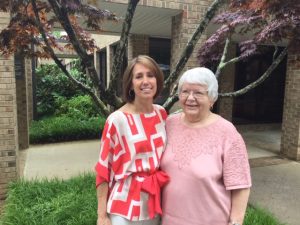 The year was 1987. I was getting ready to enter my freshman year at the University of North Carolina at Chapel Hill – go ahead, do the math. My mom and I received a letter asking us to participate in some research. Would we participate in a mother-daughter bone density study? The answer was of course yes. Now some of the details of the study are fuzzy (how can that have been over 3 decades ago?!), but to our recollection a measurement was taken on the distal radius bone and we responded to pages and pages of questions regarding our exercise and diet habits, family history, past fractures, etc. Although I never heard back, Mom was called back 1 – 2 additional times over the next several years as a part of the study.
The year was 1987. I was getting ready to enter my freshman year at the University of North Carolina at Chapel Hill – go ahead, do the math. My mom and I received a letter asking us to participate in some research. Would we participate in a mother-daughter bone density study? The answer was of course yes. Now some of the details of the study are fuzzy (how can that have been over 3 decades ago?!), but to our recollection a measurement was taken on the distal radius bone and we responded to pages and pages of questions regarding our exercise and diet habits, family history, past fractures, etc. Although I never heard back, Mom was called back 1 – 2 additional times over the next several years as a part of the study.
While we didn’t receive any information on the outcome of the study, our personal results were that we both had great bone density. We thank the other strong women and men in our family that helped to contribute to our excellent bone health. As you’re probably aware, family history isn’t the only risk factor. The National Osteoporosis Foundation, NOF, outlines the uncontrollable risk factors which include being female, over 50, menopause, small frame and history of fractures or bone loss.
However, there are many controllable factors. These include smoking, diet, exercise, and alcohol consumption. For more information concerning dietary choices for osteoporosis risk reduction check out the Chews Strategically blog “Them Strong Bones”.
Let’s talk about one of my favorite topics of discussion – Exercise and the role it can play in osteoporosis risk reduction.
We tend to hear that “weight bearing exercise” is helpful in reducing your risk for osteoporosis, but what exactly does that mean? The most comprehensive guidelines I have come across are from research compiled in the American Council on Exercise, ACE, Advanced Health Specialist Certification that outlines exercise guidelines by stages in life.
“The data clearly show that loading exercises performed prior to puberty have the greatest influence on bone.”
Children and adolescents:
- Exercise recommendations for this age group include high impact exercise and activities that place a high bending force on the bone – think of activities like gymnastics and wrestling or typical childhood play such as dropping down to the ground from monkey bars.
- Studies show that “impact exercise performed during the years before puberty produce changes in bone that are sustained into adulthood.”
Throughout our life we experience bone remodeling in which bone is both formed and removed. Osteoblasts secrete new bone and osteoclasts break down bone. A lot more is involved in this complex process including the supply of calcium and other nutrients and hormones. However, in general, we tend to do more bone formation than removal in our formative years, reaching peak bone mass around age 25. Around age 50, we, meaning both men and women, lose more bone than we form. This happens at an accelerated rate for women during menopause due changes in hormone levels.
Premenopausal Women:
- Similar to children, research shows that adults who are active tend to have higher bone mass density than their sedentary counterparts.
- Those activities that produce the highest force and loads correlate to higher bone density than low impact activities like cycling or swimming. This doesn’t mean that you shouldn’t cycle, swim or perform other non-weight bearing or low impact activities. These types of exercises just don’t correlate specifically to improved bone health. They do have numerous other benefits to cardiovascular health, etc.
- Bone-loading exercise must be performed minimum 6 months to elicit a significant response in bone density.
- Unlike the benefits seen in children in which changes in bone due to exercise may be sustained into adulthood, these exercises must be continued if you wish to maintain an increase in bone mass.
Postmenopausal women:
- Exercise takes on a maintenance roll in this age group and helps decrease the risk of fractures.
- Both high-impact exercises and strength training may have benefits on bone mass density. However, strength training further improves the risk for falls due to improved muscle strength, muscle mass and dynamic balance. High-impact training may be contraindicated for other reasons such as the presence of osteo-arthritis or other joint injury.
When it comes to exercise, bones require loads over and above normal daily loading to improve shape, size, and/or density. Since bones require an unusual loading pattern to improve, exercise that loads the skeleton in unusual, uncustomary ways produces more dramatic results. Please check with your physician before beginning any new exercise routine and then remember that regardless of your age, it's never too late to focus on bone health!
Additional resources:
